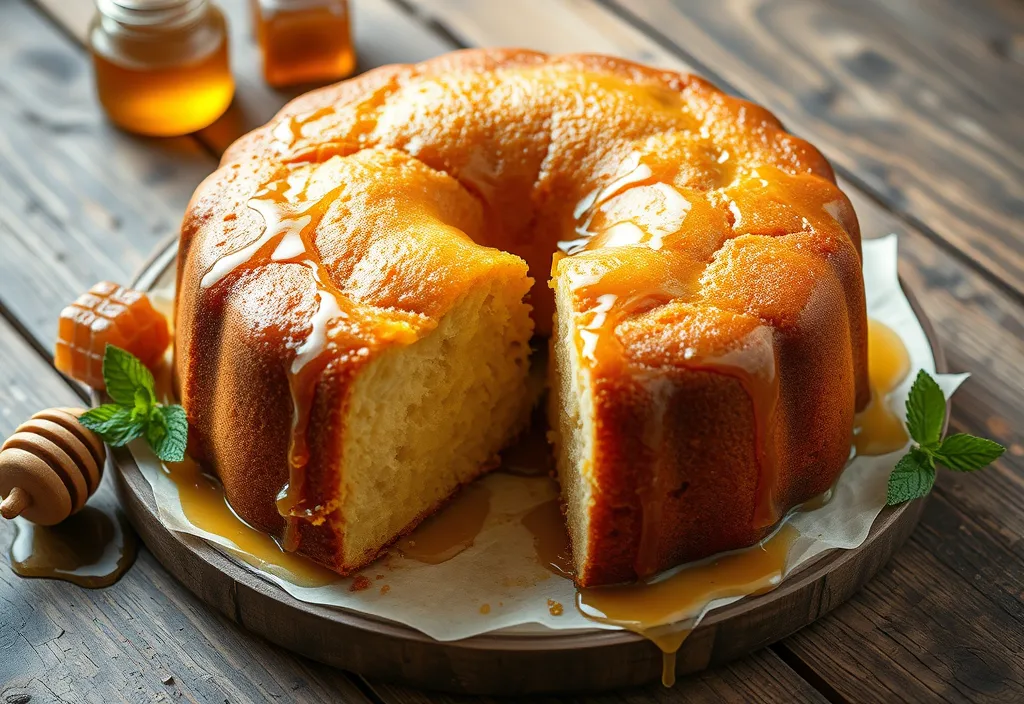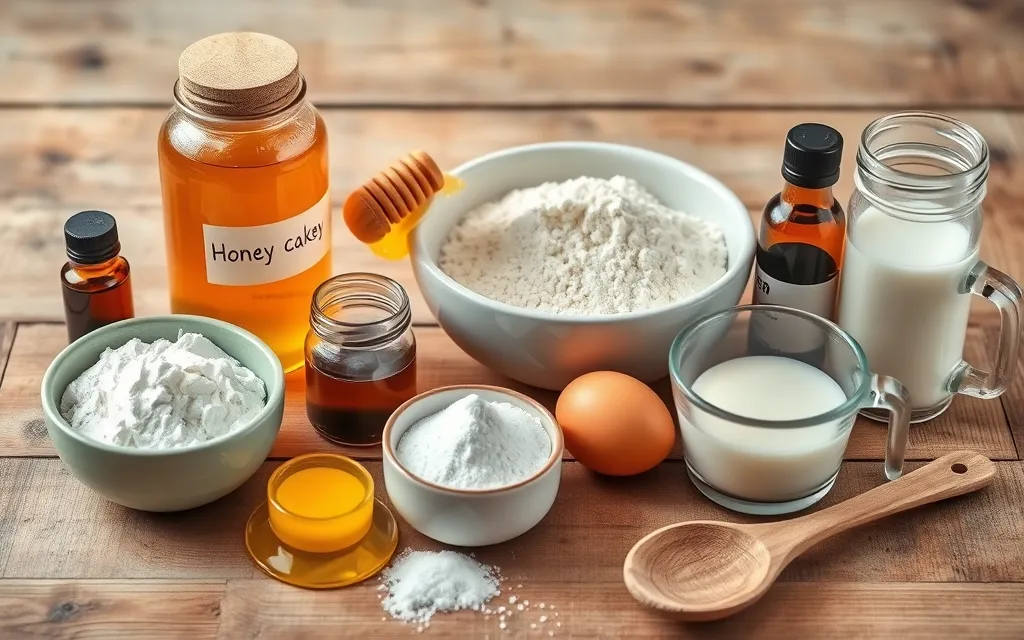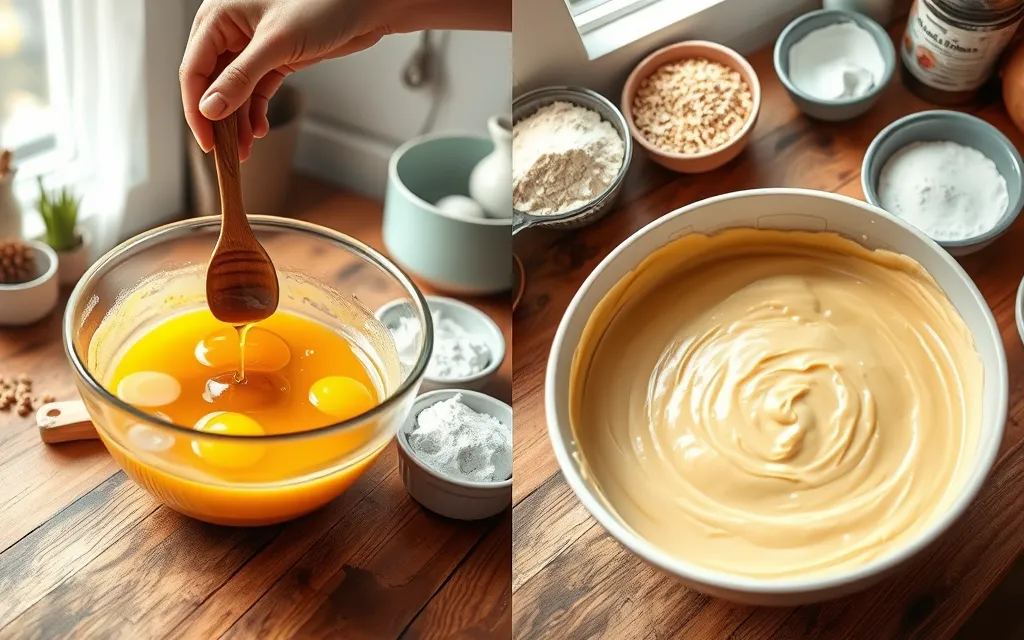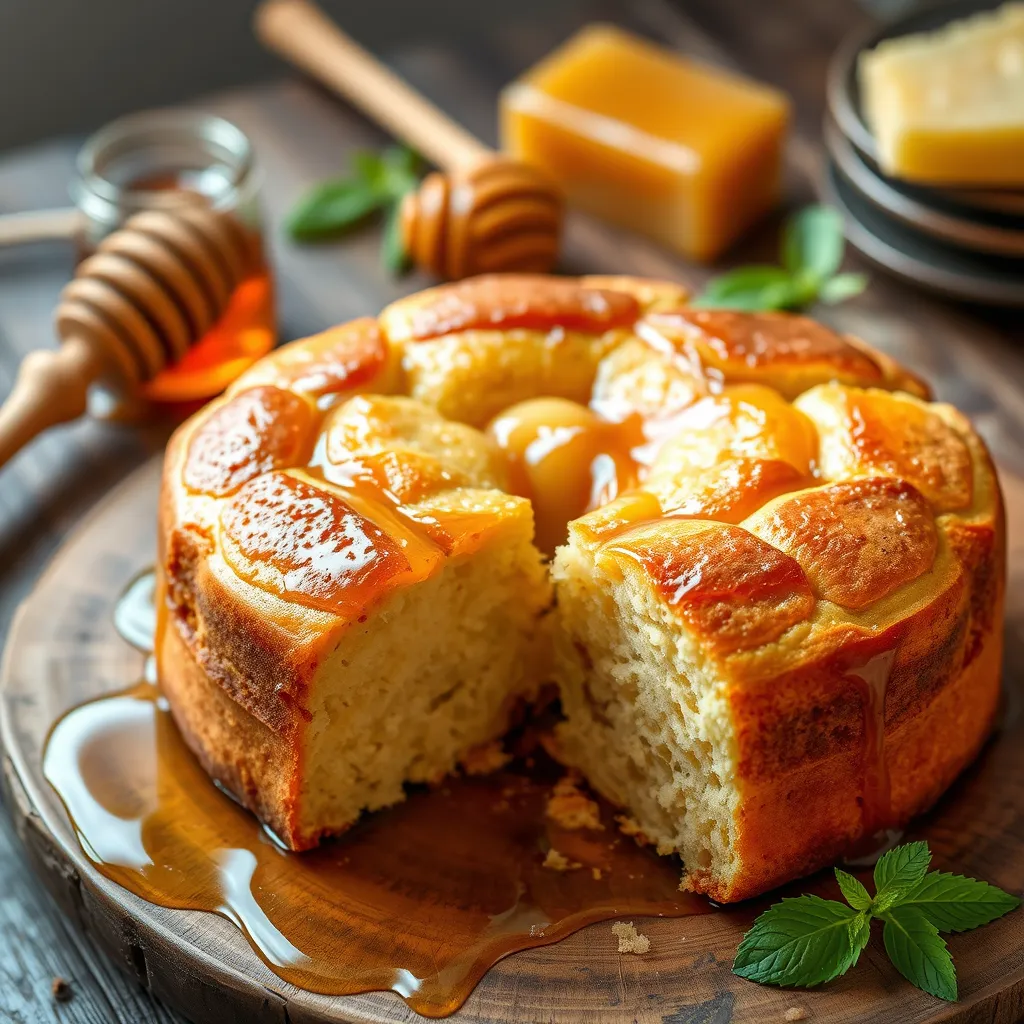Table of Contents
Introduction
Honey cake is a dessert with a rich history and a timeless appeal. Its natural sweetness, tender texture, and subtle flavors make it a favorite for holidays, family gatherings, and quiet moments with a cup of tea. This classic treat, infused with the warm, golden goodness of honey, has stood the test of time for a reason—it’s comforting, versatile, and simply delicious.

Table of Contents
In this recipe, we’ll show you how to make the best honey cake using simple ingredients and easy-to-follow steps. Whether you’re baking for a special occasion or just craving a sweet treat, this recipe is designed to deliver a cake that’s moist, flavorful, and perfect every time.
Get ready to learn how to create a dessert that’s as delightful to bake as it is to eat. With this sweet and simple honey cake recipe, you’ll have a show-stopping treat that’s sure to impress family and friends!
What Makes Honey Cake So Special?
Honey cake is more than just a dessert—it’s a timeless classic that holds a special place in the hearts of dessert lovers worldwide. Let’s dive deeper into what makes this sweet treat so unique and beloved.
The Unique Flavor of Honey
One of the most remarkable aspects of honey cake is its flavor. Honey serves as the star ingredient, lending its natural sweetness and earthy undertones to the cake. Unlike refined sugar, honey brings a depth of flavor that transforms a simple cake into a rich and aromatic delight. Additionally, the type of honey you use—whether it’s floral, clover, or wildflower—can subtly influence the taste, making each cake uniquely yours.
Honey doesn’t just sweeten the cake; it also enhances its moisture, giving the dessert a soft and tender texture. This combination of flavor and texture is what sets honey cake apart from other baked goods.
A Versatile Treat for Every Occasion
Honey cake is incredibly versatile, making it the perfect dessert for various celebrations and everyday moments. From festive holidays like Rosh Hashanah to casual afternoon tea gatherings, honey cake fits seamlessly into any occasion. Its warm and comforting flavors make it especially popular during the cooler months, but its timeless appeal ensures it’s enjoyed all year round.
Whether served plain, dusted with powdered sugar, or adorned with a drizzle of honey or glaze, honey cake is as adaptable as it is delicious. It’s a dessert that feels equally at home on a holiday table or as a cozy snack.
A Healthy Twist on Traditional Cakes
Another reason honey cake stands out is its use of honey as a natural sweetener. Honey is not only flavorful but also offers a range of health benefits. Rich in antioxidants, vitamins, and minerals, it’s a healthier alternative to refined sugar. Baking with honey adds a wholesome element to the dessert, making it feel indulgent yet nourishing at the same time.
Many variations of honey cake also include spices like cinnamon or nutmeg, which bring additional warmth and complexity to the flavor profile. These ingredients make honey cake a truly comforting and satisfying dessert that’s as good for the soul as it is for the taste buds.
H2: Ingredients You’ll Need for the Best Honey Cake
Creating the perfect honey cake starts with gathering the right ingredients. Each component plays a vital role in achieving the cake’s signature sweetness, moist texture, and irresistible flavor. Let’s break down the key ingredients, optional add-ins, and substitutions to help you make the best honey cake.

Key Ingredients
- Honey:
- The star of the show! Honey provides the cake’s natural sweetness and unique flavor. Depending on your preference, you can use floral, wildflower, or clover honey to subtly change the taste.
- For a richer and deeper flavor, consider darker honeys like buckwheat honey.
- Tip: Warm the honey slightly before mixing for easier incorporation into the batter.
- Flour:
- All-purpose flour works best for a soft and tender crumb.
- For a slightly denser texture, you can mix in whole wheat flour.
- Eggs:
- Eggs act as a binding agent, giving the cake structure and richness. Use room-temperature eggs for a smoother batter.
- Butter or Oil:
- Butter adds a rich, creamy flavor, while oil (like vegetable or canola oil) ensures the cake remains moist. Choose based on your preference—both work beautifully in honey cake.
- Sugar:
- While honey provides the primary sweetness, a small amount of sugar balances the flavor and enhances the cake’s texture. Brown sugar can add a hint of caramel-like richness.
- Spices:
- Warm spices like cinnamon, nutmeg, or ginger are optional but highly recommended to enhance the flavor. These spices pair beautifully with the honey’s natural sweetness.
- Leavening Agents:
- Baking soda and baking powder ensure the cake rises well and has a light texture.
- Liquid Ingredients:
- A combination of milk or buttermilk helps create a smooth and moist batter. You can also use non-dairy alternatives like almond or oat milk if needed.
Optional Additions
- Nuts:
- Chopped walnuts, almonds, or pecans can add a delightful crunch to your honey cake.
- Dried Fruits:
- Raisins, dates, or chopped dried apricots make excellent additions for extra sweetness and texture.
- Citrus Zest:
- A touch of lemon or orange zest can brighten the flavors and add a refreshing twist.
- Toppings:
- Consider a simple glaze made with powdered sugar and honey or a dusting of powdered sugar for a polished finish.
Substitutions and Tips
- Flour:
- For a gluten-free version, substitute all-purpose flour with a gluten-free flour blend.
- Sweeteners:
- If you prefer a slightly less sweet cake, reduce the sugar or replace it with a natural alternative like coconut sugar.
- Dairy-Free Options:
- Replace butter with coconut oil or vegan butter, and use plant-based milk for a dairy-free honey cake.
- Egg-Free Option:
- Use flax eggs or applesauce as a substitute for eggs to make the cake vegan-friendly.
By carefully selecting and preparing your ingredients, you’ll set the stage for a honey cake that’s moist, flavorful, and perfectly balanced. Whether you stick to the traditional recipe or add your own creative twists, the right ingredients are key to baking success!

Step-by-Step Guide to Making Honey Cake
Baking honey cake is a rewarding process that fills your kitchen with warm, comforting aromas and results in a dessert that’s as beautiful as it is delicious. Follow these detailed steps to ensure your honey cake turns out perfectly every time.
Preparing Your Ingredients and Equipment
Before diving into the baking process, preparation is key. Here’s how to set yourself up for success:
- Preheat the Oven:
- Set your oven to 350°F (175°C) to ensure it’s at the perfect temperature when your batter is ready. Proper preheating is essential for even baking.
- Prepare Your Cake Pan:
- Grease your cake pan thoroughly with butter or oil and lightly dust it with flour to prevent sticking. Alternatively, use parchment paper for easy release.
- Gather Your Tools:
- Essential tools include a large mixing bowl, a whisk or electric mixer, a spatula, and a measuring set for accuracy.
- Ensure all your equipment is clean and dry to avoid issues with the batter consistency.
- Bring Ingredients to Room Temperature:
- Room-temperature eggs, butter, and milk mix more easily, ensuring a smoother batter and even texture in your cake.
Mixing and Combining the Batter
The batter is the heart of your honey cake. Follow these steps to blend the ingredients to perfection:
- Cream the Wet Ingredients:
- In a mixing bowl, whisk the eggs and sugar together until light and frothy. This step helps create a fluffy texture.
- Gradually add the honey and melted butter (or oil) while continuing to mix. The honey should blend smoothly with the other wet ingredients.
- Incorporate the Dry Ingredients:
- In a separate bowl, sift together the flour, baking soda, baking powder, and spices (like cinnamon or nutmeg). Sifting ensures there are no lumps and helps the batter mix evenly.
- Combine Wet and Dry Ingredients:
- Slowly add the dry mixture to the wet ingredients in small batches, mixing gently to avoid overworking the batter. Overmixing can lead to a dense cake.
- Add Liquids:
- Stir in the milk or buttermilk to create a smooth, pourable batter. At this stage, fold in any optional add-ins, like nuts or dried fruits, for extra flavor and texture.
Baking and Cooling Your Cake
The baking stage requires precision to achieve a moist and tender honey cake:
- Pour the Batter into the Pan:
- Evenly distribute the batter into the prepared cake pan. Lightly tap the pan on the counter to release any air bubbles.
- Bake:
- Place the pan in the preheated oven and bake for 40–50 minutes, depending on the size of your pan. Check for doneness by inserting a toothpick into the center—it should come out clean or with just a few crumbs.
- Cool the Cake:
- Allow the cake to cool in the pan for 10–15 minutes before transferring it to a wire rack. Cooling fully before frosting or serving is crucial to maintain the texture and flavor.
Optional Frosting Ideas
While honey cake is delicious on its own, adding frosting or a drizzle can elevate its presentation and flavor:
- Cream Cheese Glaze:
- Whisk together cream cheese, powdered sugar, and a splash of milk until smooth. Spread or drizzle over the cooled cake for a tangy contrast to the sweet honey.
- Honey Drizzle:
- Warm a few tablespoons of honey and drizzle it over the cake for an elegant, glossy finish. You can also sprinkle crushed nuts over the drizzle for added texture.
- Powdered Sugar Dusting:
- For a simple yet elegant touch, sift powdered sugar over the top of the cake. It’s quick, easy, and visually appealing.
- Spiced Buttercream Frosting:
- Blend butter, powdered sugar, a hint of cinnamon, and a splash of honey to create a rich, spiced buttercream frosting. Spread it generously for a decadent finish.
Tips for Perfecting Your Homemade Honey Cake
Baking the perfect honey cake is both an art and a science. With a few simple tricks, you can ensure that your cake has the ideal texture, flavor, and appearance every time. Let’s dive into some expert tips to make your homemade honey cake truly exceptional.
Achieving the Right Texture
The texture of honey cake is one of its most defining features. A perfectly baked honey cake should be moist, tender, and light. Here’s how to achieve that:
- Measure Ingredients Accurately:
- Baking is all about precision. Use measuring cups and spoons to ensure the correct ratio of wet and dry ingredients. Too much flour can make the cake dense, while too much liquid can lead to a gummy texture.
- Don’t Overmix the Batter:
- When combining the wet and dry ingredients, mix only until just combined. Overmixing develops gluten in the flour, which can result in a dense or chewy cake instead of the light and fluffy texture you want.
- Incorporate Air Into the Batter:
- Whisk the eggs and sugar together thoroughly before adding other ingredients. This step introduces air into the batter, contributing to a fluffy cake.
- Use the Right Pan Size:
- The size and material of your pan affect how the cake bakes. Too small a pan can lead to uneven baking, while too large a pan may cause the cake to dry out. Use the size recommended in the recipe for the best results.
- Check for Doneness Early:
- Start checking your cake a few minutes before the recommended baking time. Insert a toothpick into the center; it should come out clean or with a few moist crumbs, not wet batter.
Balancing Flavors
The balance of sweetness and spices is what makes honey cake so delightful. Adjusting these elements to suit your preferences is key:
- Adjusting the Honey:
- If you prefer a less sweet cake, you can slightly reduce the amount of honey without compromising the texture. For an extra burst of flavor, try using a bold, robust honey like buckwheat or eucalyptus.
- Adding Spices:
- Warm spices like cinnamon, nutmeg, or cardamom can elevate the flavor profile. Start with small amounts and adjust based on your taste preferences.
- Enhancing with Zest or Extracts:
- A teaspoon of vanilla extract or a bit of orange or lemon zest can add brightness and complexity to the cake without overpowering the honey’s natural flavor.
- Balancing Sweetness:
- If your honey is particularly sweet, pair it with a tangy frosting (like cream cheese) or add a pinch of salt to the batter to balance the flavors.
Common Mistakes to Avoid
Even experienced bakers can encounter pitfalls when making honey cake. Avoid these common mistakes to ensure a flawless result:
- Overmixing the Batter:
- Overmixing can make the cake dense and chewy instead of light and airy. Once the dry ingredients are added, mix gently and stop as soon as everything is incorporated.
- Uneven Baking:
- To avoid uneven baking, place your cake pan in the center of the oven. Rotate the pan halfway through baking if your oven has hot spots.
- Skipping Cooling Time:
- Cutting into the cake too soon can cause it to crumble or lose its structure. Allow the cake to cool in the pan for 10–15 minutes before transferring it to a wire rack to cool completely.
- Using Cold Ingredients:
- Cold butter, eggs, or milk can make the batter lumpy and uneven. Ensure all ingredients are at room temperature before starting.
- Not Preheating the Oven:
- Baking in an oven that isn’t fully preheated can lead to uneven rising and baking. Always preheat your oven to the correct temperature before putting the cake in.
Serving Suggestions and Storage Tips
How to Serve Honey Cake
- Serve slices with tea or coffee for a cozy pairing.
- Add a dollop of whipped cream or a drizzle of honey for extra indulgence.
- Garnish with fresh fruits or nuts for a decorative touch.
Storing Your Honey Cake
- Store the cake in an airtight container at room temperature for up to 3 days.
- Refrigerate for up to a week to maintain freshness. Allow the cake to come to room temperature before serving.
Freezing for Later
- Wrap the cake tightly in plastic wrap, then place it in a freezer-safe bag or container.
- Freeze for up to 3 months. Thaw at room temperature for a few hours or overnight in the fridge.
Conclusion
Honey cake is a classic dessert that’s simple to make, yet packed with flavor and charm. Whether you’re baking for a special occasion or just because, this sweet and simple recipe is sure to delight. Try it today and discover why honey cake has been a beloved treat for generations. Don’t forget to share your results or your favorite variations in the comments below—we’d love to hear from you!
Variations of Honey Cake to Try
Spiced Honey Cake
If you love a cake with a little more warmth and complexity, try adding a mix of spices like cloves, allspice, or cardamom to your honey cake batter. These spices pair beautifully with the natural sweetness of honey, creating a cake that’s perfect for fall or winter celebrations. You can also experiment with different types of honey, such as buckwheat honey, which has a deeper, more robust flavor.
Carrot Honey Cake
For a slightly healthier twist, try adding grated carrots to your honey cake. The carrots provide moisture and sweetness, while also adding a beautiful orange color to the cake. This variation pairs wonderfully with a cream cheese frosting, enhancing the flavor while maintaining that classic honey sweetness.
Nutty Honey Cake
Add chopped nuts like almonds, walnuts, or hazelnuts to the batter for a bit of crunch. The nuts not only complement the honey’s natural sweetness but also give the cake extra texture and richness. For an even more decadent treat, sprinkle some toasted nuts on top of the cake as a garnish.
Chocolate Honey Cake
For chocolate lovers, try incorporating cocoa powder or melted dark chocolate into your honey cake batter. The deep flavor of the chocolate balances perfectly with the honey, creating a rich, indulgent cake that’s perfect for special occasions. You can also drizzle some chocolate ganache over the cake for an extra touch of decadence.

